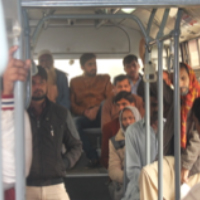Travel behaviour variations between urban and rural areas of Pakistan
Abstract
This paper examines the 2007 national time use survey to report the degree to which the national travel behaviour varies between urban and rural of Pakistan and how it is shaped by the local socioeconomic and individual characteristics in these areas. At the national level, walking remains the dominant mode of daily mobility across the country. However, the daily trip rate, mode choice and travel durations vary significantly across both geographies. Urban residents are slightly less mobile and exhibits greater use of personal automobile than rural residents. These differences become more pronounced across gender. There exists slight local regional variation across provinces which are closely related to the local social and spatial drivers of mobility. The paper speculates that the rural travel differences are mainly caused by difference in income levels. Urban built environment is more conducive to motorized mobility which results in greater automobile reliance in cities, particularly for women. Social and cultural environment also plays potentially significant and spatially explicit role which remains under addressed and calls for further research.
Downloads
References
Adeel, M., Yeh, A. G. O., & Zhang, F. (2016). Transportation disadvantage and activity participation in the cities of Rawalpindi and Islamabad, Pakistan. Transport Policy, 47, 1-12. doi: https://doi.org/10.1016/j.tranpol.2015.12.001
Adeel, M., Yeh, A. G. O., & Zhang, F. (2017). Gender inequality in mobility and mode choice in Pakistan. Transportation, 44(6), 1519-1534. doi: ttps://doi.org/10.1007/s11116-016-9712-8
De Vos, J., Derudder, B., Van Acker, V., & Witlox, F. (2012). Reducing car use: changing attitudes or relocating? The influence of residential dissonance on travel behavior. Journal of Transport Geography, 22, 1-9. doi: https://doi.org/10.1016/j.jtrangeo.2011.11.005
Haider, M., & Badami, M. (2004). Public transit for the urban poor in Pakistan: Balancing efficiency and equity. Proceedings from the Forum on Sustainable Infrastructure and Service Delivery for the Urban Poor. New Delhi, India: Woodrow Wilson International Center for Scholars.
Houshmand, M. E. (2017). Active Transport to School and Children's Body Weight: A Systematic Review. TeMA Journal of Land Use, Mobility and Environment, 10(1), 95-110. doi: http://dx.doi.org/10.6092/1970-9870/4088
Imran, M. (2009). Public transport in Pakistan: a critical overview. Journal of Public Transportation, 12(2), 4. doi: http://dx.doi.org/10.5038/2375-0901.12.2.4
International Food Policy Research Institute [IFPRI]. (2016). Pakistan’s changing demography: Urbanization and peri-urban transformation over time (Vol. 39). Kedir, M., Schmidt, E., & Wagas, A.
Japan International Cooperation Agency [JICA]. (2008). The project for Lahore urban transport master plan in the Islamic Republic of Pakistan: Final report. Lahore, Pakistan: Japan International Cooperation Agency, ALMEC Corp., Oriental Consultants Co., Ltd.
Levinson, D.M. (2016). A random walk down Main Street. TeMA Journal of Land Use, Mobility and Environment, 9(2), 163-172. doi: http://dx.doi.org/10.6092/1970-9870/3914
Millward, H., & Spinney, J. (2011). Time use, travel behavior, and the rural–urban continuum: results from the Halifax STAR project. Journal of Transport Geography, 19(1), 51-58. doi: https://doi.org/10.1016/j.jtrangeo.2009.12.005
Morrill, R., Cromartie, J., & Hart, G. (1999). Metropolitan, urban, and rural commuting areas: toward a better depiction of the United States settlement system. Urban Geography, 20(8), 727-748. doi: https://doi.org/10.2747/0272-3638.20.8.727
Niglio, R., & Comitale, P. P. (2015). Sustainable urban mobility towards smart mobility: The case study of Bari area, Italy. TeMA Journal of Land Use, Mobility and Environment, 8(2), 219-234. doi: http://dx.doi.org/10.6092/1970-9870/3009
Pakistan Bureau of Statistics [PBS]. (2009). Time Use Survey 2007. Islamabad, Pakistan: Pakistan Bureau of Statistics.
Pakistan Bureau of Statistics [PBS]. (2017). Province-wise provisional results of census 2017. Islamabad, Pakistan: Pakistan Bureau of Statistics.
Pucher, J., & Renne, J. L. (2005). Rural mobility and mode choice: Evidence from the 2001 National Household Travel Survey. Transportation, 32(2), 165-186. doi: https://doi.org/10.1007/s11116-004-5508-3
Qureshi, I. A., & Lu, H. (2007). Urban transport and sustainable transport strategies: A case study of Karachi, Pakistan. Tsinghua Science & Technology, 12(3), 309-317. doi: https://doi.org/10.1016/S1007-0214(07)70046-9
Russell, J. R., & Anjum, G. A. (1997). Public transport and urban development in Pakistan. Transport Reviews, 17(1), 61-80. doi: https://doi.org/10.1080/01441649708716969
United Nations Department of Economic and Social Affairs, Population Division. (2002). World urbanization prospects: the 2001 revision (Vol. 216). New York, NY: United Nations Department of Economic and Social Affairs, Population Division.

Copyright (c) 2018 Tema. Journal of Land Use, Mobility and Environment

This work is licensed under a Creative Commons Attribution 4.0 International License.
Authors who publish in this journal agree to the following:
1. Authors retain the rights to their work and give in to the journal the right of first publication of the work simultaneously licensed under a Creative Commons License - Attribution that allows others to share the work indicating the authorship and the initial publication in this journal.
2. Authors can adhere to other agreements of non-exclusive license for the distribution of the published version of the work (ex. To deposit it in an institutional repository or to publish it in a monography), provided to indicate that the document was first published in this journal.
3. Authors can distribute their work online (ex. In institutional repositories or in their website) prior to and during the submission process, as it can lead to productive exchanges and it can increase the quotations of the published work (See The Effect of Open Access)
